Pan Am once ruled the skies. Will Miami airport save airline’s historic buildings?
Long gone but not quite forgotten, Pan American Airways once dominated international airplane travel — a business the pioneering company created and developed out of a hangar at a little airfield its founder built on a farm field on Miami’s outskirts in 1928.
Today the airfield is known as Miami International Airport. And, unbeknownst to all but a few insiders, the hangar that gave rise to Miami’s famed airport still survives, having outlived Pan Am by 42 years in fully functional fashion. MIA building 871, originally known as Pan Am Airport’s Hangar 5, now serves a Miami air charter company that has counted the Miami Heat and the U.S. military as frequent flyers.
As it nears its centennial, however, the hangar’s days may be numbered. It’s been designated by airport officials for eventual demolition and replacement.
But a group of devotees of Pan Am and Miami’s aviation history want to save it. And they may get the backing of Miami-Dade County’s historic preservation board.
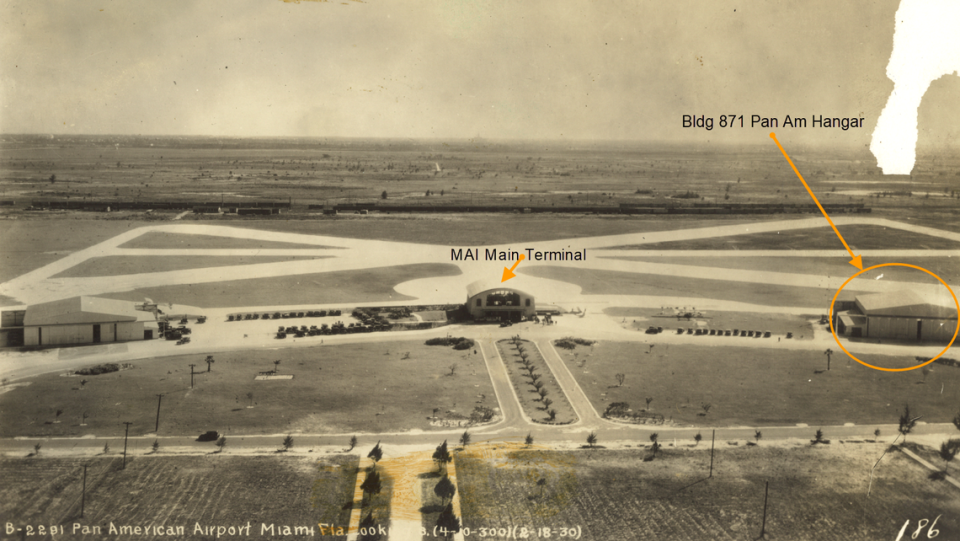
Operators of charter company Miami Air International and its corporate parent, World Atlantic Airlines, are pressing the preservation board to designate the old Pan Am hangar as a protected historic site. They argue the building constitutes a singular landmark not only in the history of Miami airport, Pan Am and U.S. and international aviation, but in the development of Miami itself.
By making Miami the center of its early network of international flights to the Caribbean and Latin America, they contend, Pan Am helped cement the city’s place as the capital of the Americas.
And it all originated at Hangar 5, built by legendary Pan Am founder Juan Trippe. Pan Am launched the first commercial international flights out of the United States, established the first worldwide air networks, built airports across the hemisphere, pioneered jet passenger travel and helped introduce the 747 jumbo jet before shockingly succumbing in 1991.
“This is it, this is where it all started,” said Miami Air’s vice president for operations, Armando Martinez, a former Pan Am Express pilot whose wife was a flight attendant at the iconic airline, as he gave a tour of the hangar. “It is the oldest building in the airport, and we still have a chance to save it. Why would you want to let it go?”
So far, the preservation board is listening.
Although county preservation chief Sarah Cody concluded in a preliminary report that the hangar meets the legal criteria for historic designation, she recommended against pursuing it, saying the airport needs the site for other uses and it’s not publicly accessible. But the board earlier this year narrowly voted 4-3 to ask Cody for a full analysis. That report is pending. A Miami airport spokesman, meanwhile, said airport administrators have no immediate plans to tear down the old hangar.
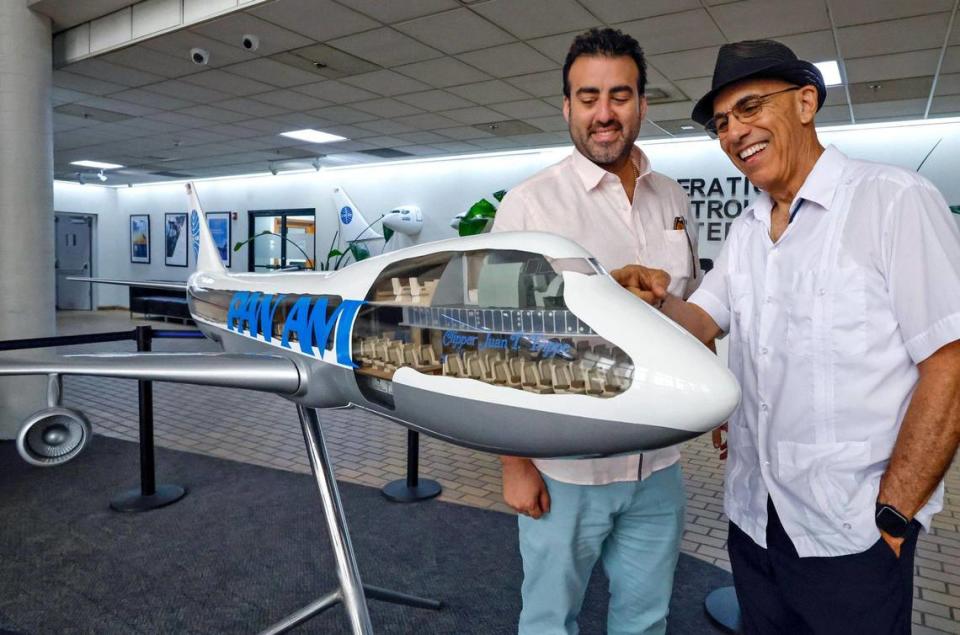
Pan Am’s ‘Taj Mahal’
The tussle comes as Miami-Dade embarks on a substantial plan to rescue Hangar 5’s far grander next-door neighbor, another Pan Am landmark at MIA — the airline’s long-vacant former regional headquarters, widely regarded as a paragon of Miami Modern architecture and designated as an historic structure by the county since 2014.
Where the steel-trussed Pan Am hangar is impressive but utilitarian, the Pan Am headquarters was designed to dazzle.
The two-story 1963 building, set behind a long reflecting pool that fronts Northwest 36th Street, was nicknamed the Taj Mahal both for its layout, which recalls that of the famous 17th Century mausoleum in India, and its sumptuous tropical Modern design, which resembles that of the U.S. Embassy in New Delhi from 1959.
The squared-off Pan Am building’s overhanging flat roof is supported by slender gold metallic columns. A stairway leads up to an elevated first-floor entryway lined with gold-anodized panels and covered by a projecting canopy that extends through the lobby to an interior courtyard. The lobby and courtyard are decorated with Pan Am’s once-familiar globe logo molded into walls in repeating patterns. A floating, curving stairway with gold railings leads from the lobby to the second floor.
All four sides of the building, designed by the Miami firm of Steward-Skinner and Associates — prominent architects of the day also responsible for the design of Miami Seaquarium and MIA’s first jet-age terminal — are covered by an intricate concrete sun screen of interlocking trapezoidal pieces.
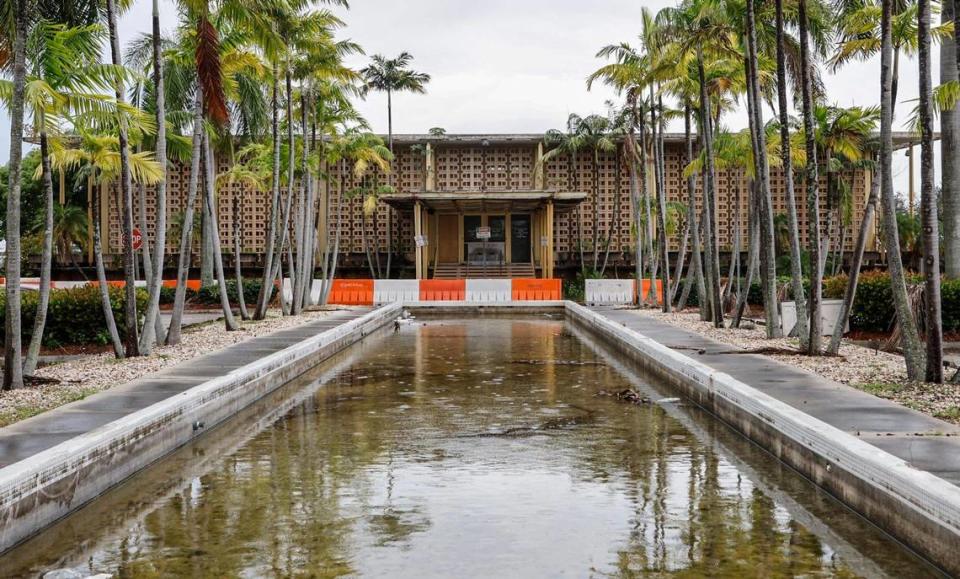
Once Pan Am ceased operations in 1991 following a bankruptcy blamed in part on airline deregulation, increased competition and rising costs, Miami airport took over the headquarters building, which also housed the airline’s flight-attendant training school. Though initially leased to other aviation companies, the building has been shuttered and deteriorating since 1996.
Luxury private terminal
In April, the Miami-Dade Commission approved a bid by a private company, PS, to convert the Pan Am building into a luxurious private terminal for elite flyers willing to pay to avoid the airport’s crowded concourses. Under the deal, expected to yield $16 million in lease payments to the county over its 20-year life, PS will spend at least $4 million to renovate and refurbish the building.
Under the PS plan, the Pan Am building will become a refuge for affluent travelers flying commercial — not on private planes. The second floor will be turned into hotel-like suites where those seeking privacy can rest, bathe, dine and drink, while the first floor will be converted into two plush lounges, also with food and beverage service.
Speedy security, customs and immigration checks will be done on site, and passengers will be chauffeured directly to and from their aircraft door.

The plan calls for meticulous restoration of the building’s original architecture and design details in its public spaces, including the gold panels and accents and the Pan Am logos on the lobby and courtyard walls, said Richard Heisenbottle, the Miami architect overseeing the building’s preservation for PS. The terminal would open in 2025.
“We are really saving and restoring everything that was part of the Pan Am experience,” Heisenbottle said. “They were the best in the sky, let’s face it, for many, many years. All the ornamentation that represents Pan Am is being restored and kept, and it’s going to look pretty damn spectacular.”
Paul George, resident historian at the HistoryMiami museum and a member of the county preservation board, called the rehabilitation of the Pan Am building a rare big win for historic sites at a time when real estate development pressure has led to the loss of many others.
“That is a historic-preservation triumph,” George said. “There aren’t a lot of them. ”
It won’t come cheap for users, though.
At Los Angeles International Airport, where PS runs a similar private terminal, the company charges a yearly membership fee of up to $4,850, plus up to $3,150 additional per flight, which covers a private suite for the member and three other passengers. Non-members can use the facility for a no-frills base rate of $995 a person. The company is also opening private terminals at the Atlanta and Dallas airports over the next year.
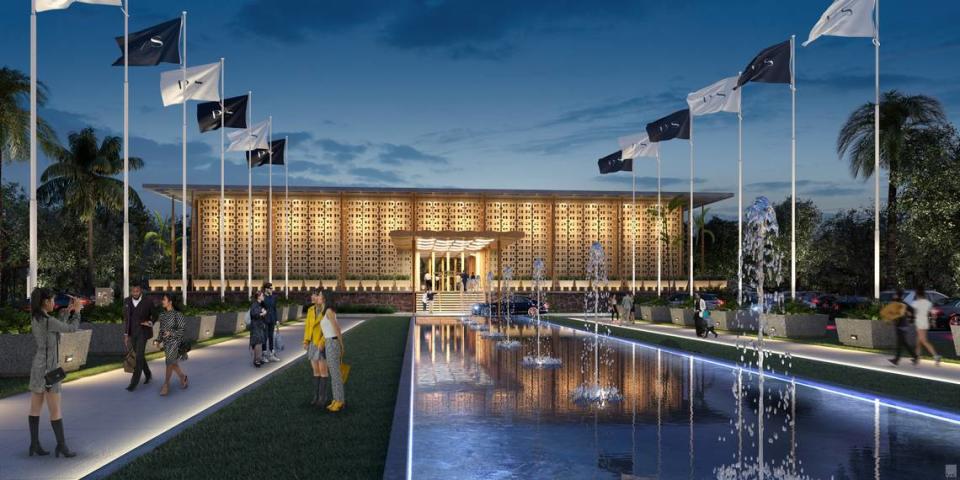
Martinez and his boss, World Atlantic general manager Tomas Romero, applaud the work and attention being lavished on the renovation project next door. But they say the old Pan Am hangar, though perhaps modest by comparison, is just as significant a piece of history, if not more so.
Sept. 15, 1928: First Pan Am flight from Miami
The hangar was first built in Key West in 1927, when Trippe launched the world’s first international commercial flight, between the island and Havana. But he soon concluded that the future lay 150 miles north in Miami. He bought a 116-acre field from the Seminole Fruit Company, then had the hangar disassembled and rebuilt on the Miami site in 1928. On Sept. 15 of that year, the inaugural flight from the fledgling airport took place — a mail transport to Havana with only two passengers, according to a county report.
Trippe rapidly expanded his flight service and the number of hangars and other facilities at the airfield, including the world’s first dedicated air terminal. The rest was long ago demolished, leaving just Hangar 5 as the sole remnant of Pan Am and Miami airport’s earliest days.
George, the historian, said there’s no question of the hangar’s link to Pan Am and MIA history, though he said he can’t comment on whether it merits designation as a historic site because he likely will be voting on the question.
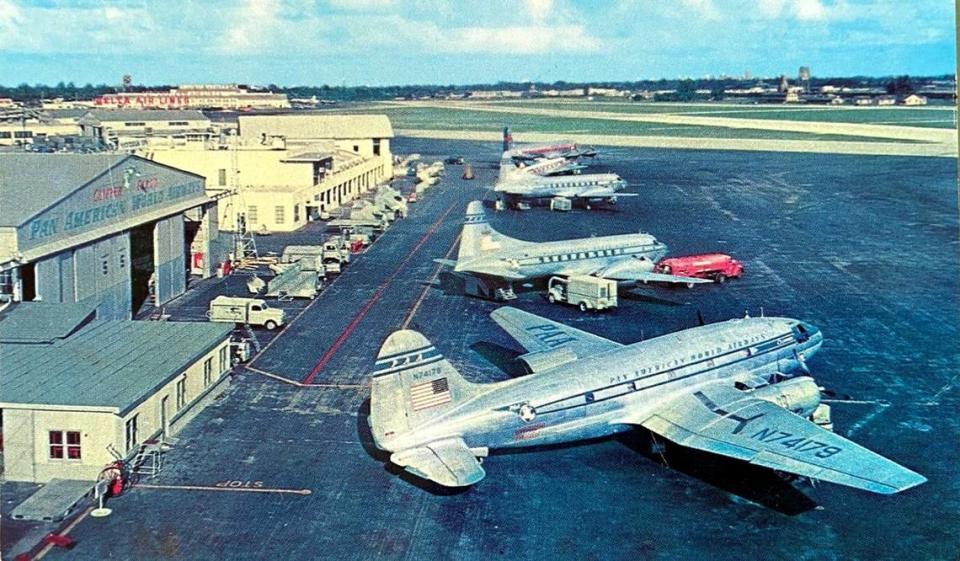
Trippe also built hangars and a terminal for Pan Am’s seaplanes at Coconut Grove’s Dinner Key, but those came a few years later, in 1932. Today the seaplane terminal, also painstakingly restored under Heisenbottle’s direction, is Miami City Hall. Two of the old Pan Am hangars, designated as historic by the city of Miami, also were recently renovated for commercial use as part of TREO Group and Grove Bay Hospitality Group’s Regatta Harbour dining and entertainment project.
Historic designation question
In her report recommending that Hangar 5 not be considered for historic designation, Cody said that the easily accessible and prominently visible Dinner Key buildings better serve to tell the story of Pan Am and early aviation in Miami. Her report also claims the hangar needs structural repairs and no longer meets FAA criteria for aircraft maintenance use.
Martinez and Romero, though, say the claims are incorrect. They say they have sunk considerable money into repairing corroded steel columns and updating the hangar’s fire-suppression systems to meet current building codes and FAA requirements. They are awaiting final approval from the federal agency and a 40-year building recertification from the county.
They also hope to set aside space in the expansive hangar for a museum dedicated to Pan Am history and artifacts, including some now on display at the adjacent building housing the Pan Am Flight Academy — the airline’s only surviving piece. That building, too, is slated for eventual replacement, and the artifacts, including a see-through 747 model, a Pan Am mural and historic photographs, will need a new home.
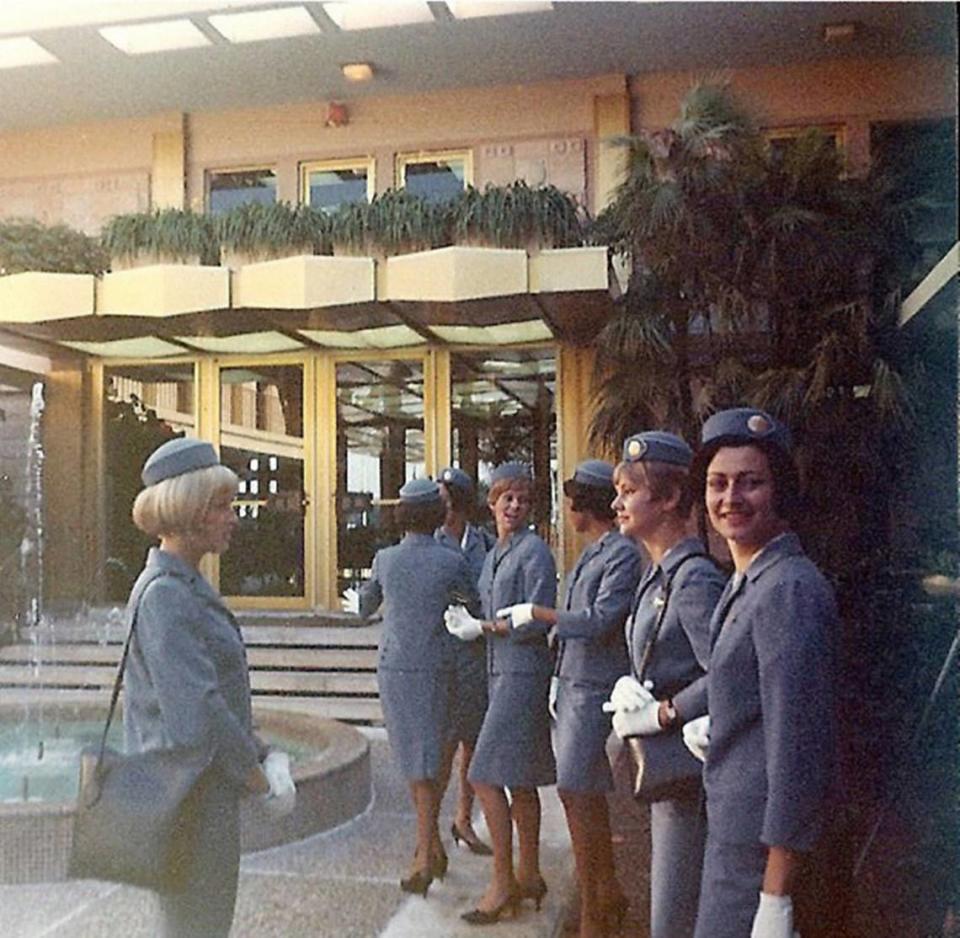
Ironically, Martinez said, MIA administrators have said one possible use for the Hangar 5 site is as a valet parking lot for the new private terminal at the Pan Am building.
But he said the Pan Am building restoration only underscores the importance of the even older Hangar 5, and how a creative approach could save it for the next 100 years.
“This facility was built like a tank. It doesn’t leak at all. It’s been through many hurricanes,” Martinez said.
It’s also, he said, a part of his personal history. Born in Cuba, he came to Miami with his family as a boy before the Revolution, and has been obsessed with flying since he was a teenager. As a pilot for Pan Am’s commuter flight service, he was waiting for a chance to fly its big jets when the airline went out of business. He did eventually get his turn to pilot 747s, but for cargo giant Atlas Air.
At Hangar 5, he said, he can feel the tug of history.
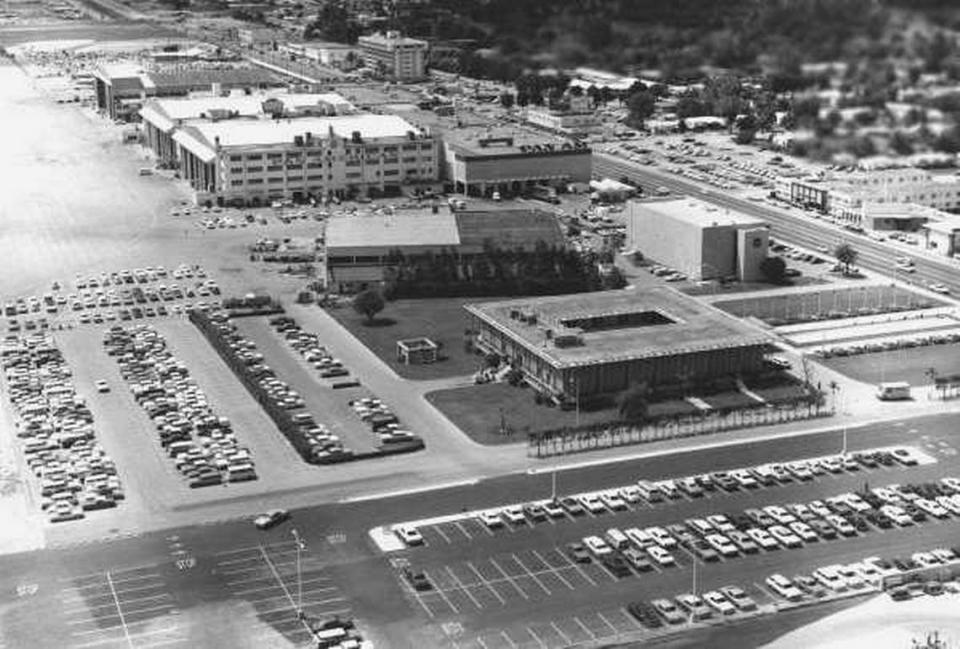
“What people don’t understand is that Pan Am created most of the air routes and air travel,” Martinez said. “They have already torn down everything that had to do with Pan Am and the beginning of aviation at Miami International. I’m 77 years old. I’m about ready to retire, but this is what I’m fighting for. I get emotional when I speak about this.
“It’s in my blood. Our heart and soul is into this.”

